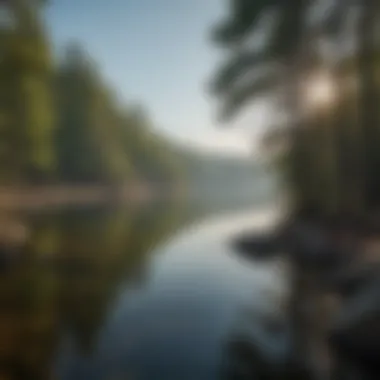Exploring Lake Ouachita: Nature and Recreation in Arkansas


Intro
Lake Ouachita, nestled in the heart of Arkansas, is not just a picturesque getaway, but also a significant ecological treasure. This expansive body of water, surrounded by lush forests, offers a unique opportunity to explore its remarkable ecosystem and the myriad recreational activities it affords. Yet, it is the interdependence between the lake and its surrounding woodland that plays a vital role in supporting local biodiversity and promoting sustainable tourism practices.
In this guide, we will delve into the intricate dynamics of woodland ecosystems, focusing on the importance of biodiversity and the role forests play in climate regulation. We will then shift to discussing sustainable forestry practices that have proven effective in preserving these vital environments. Lastly, we will examine woodland stewardship techniques that not only promote conservation but also engage local communities in protecting their natural heritage.
This comprehensive exploration aims to equip forestry professionals and environmentally-minded individuals alike with a deeper understanding of the ecological and community frameworks surrounding Lake Ouachita. By fostering an appreciation for this treasured area, we can all become more responsible stewards of our natural world.
Foreword to Lake Ouachita
Lake Ouachita, a sprawling gem nestled in the heart of Arkansas, serves not only as a haven for outdoor enthusiasts but also as a crucial ecological asset deserving of recognition. Whether one intends to navigate its waters, study its diverse flora and fauna, or simply bask in its natural beauty, understanding its foundational significance lays the groundwork for truly appreciating all that it offers. The lake offers a nourishing environment both for the wildlife that call it home and for those who venture to explore its borders.
Geographical Context
Lake Ouachita is strategically located in the Ouachita Mountains, spreading across more than 40,000 acres. Its waters are fed by the Ouachita River and are bordered by diverse forests, which add to the aesthetic charm and ecological richness of the area. The lake’s varied topography includes deep coves, rocky shorelines, and exposed islands that create unique habitats ideal for numerous species.
Access to Lake Ouachita is relatively straightforward, with several roads leading to it from more urban areas like Hot Springs and Little Rock. More than just a beautiful view, the lake's position within the Ouachita National Forest amplifies its significance, integrating it into a network of ecosystems that provide vital services—making it a linchpin in local biodiversity.
Historical Background
Understanding Lake Ouachita also involves traveling back in time to see how it evolved into a treasured resource. Originally, the region was home to Native American tribes, such as the Ouachita and Caddo, who utilized the land and water for sustenance and spiritual practices. The creation of the lake began in the late 20th century when the U.S. Army Corps of Engineers constructed the Blakely Mountain Dam, officially flooding the area in 1953.
This monumental decision aimed to control flooding and generate hydroelectric power, but also transformed the local landscape entirely. As a nested artificial lake, Lake Ouachita is often considered one of the cleanest large lakes in the United States, its waters pristine compared to many others suffering from pollution. Today, Lake Ouachita stands as a testament to human ingenuity balanced with a commitment to preserving natural beauty—making it a point of pride for Arkansans and a focal point for scholars studying natural resource management.
Ecological Significance of Lake Ouachita
Lake Ouachita is not just a picturesque destination; it serves as a crucial ecological backbone for the surrounding area. This expansive lake, encompassing over 40,000 acres, acts as a habitat for various species and plays a vital role in the integrity of local ecosystems. The lake's significance lies in its rich biodiversity, contributing to both the environmental health and recreational value of the region. Understanding its ecological aspects can help to appreciate the delicate balance maintained within this aquatic environment.
Biodiversity at Lake Ouachita
Flora
The flora populating Lake Ouachita is as varied as it is vibrant. Dominated by species such as oak, hickory, and pine, the vegetation around the lake provides essential services that many might take for granted. One key characteristic of these plants is their adaptability. They thrive in both wet and dry conditions, which is essential for sustaining local wildlife and ensuring soil stability. Unique features, such as the sprawling wildflowers during the spring months, not only enhance the visual landscape but also offer numerous advantages.
For example, these blossoms attract pollinators, playing a significant role in the ecosystem's reproduction cycle. However, invasive species pose a challenge to the natural flora, impacting growth patterns and biodiversity overall. Thus, visitors must be vigilant about not disturbing native habitats when enjoying outdoor activities.
Fauna
Likewise, the fauna of Lake Ouachita is a tapestry of life that enhances its ecological significance. From the majestic bald eagle soaring high above to the small but critical insects flitting about, the animal life here contributes immensely to the ecosystem. The lake is home to over 200 species of fish, including largemouth bass and catfish. This wealth of aquatic life draws both anglers and nature enthusiasts alike. A key attribute of this fauna is its role in the food web, where every creature has a part to play in sustaining others.
The diverse animal community also aids in controlling pest populations while simultaneously enriching the soil with their natural behaviors. However, climate changes pose a threat to these species, potentially altering their habitats and migration patterns. By understanding the fauna's role, conservationists can better plan for the preservation of these vital species.
Aquatic Ecosystems
The aquatic ecosystems within Lake Ouachita are critical not just for the flora and fauna but for maintaining the overall health of the lake. The mix of freshwater environment, aquatic plants, and varying depths creates a unique habitat. These ecosystems serve as spawning grounds for fish, nurseries for aquatic life, and filter systems for water quality. They play an essential part in sequestering carbon, thereby enhancing climate resilience.
Moreover, the interactions between the water and surrounding land contribute to nutrient cycling, ensuring that the ecosystems remain productive. As such, everything from the tiniest plankton to the largest fish relies on these aquatic environments for survival. Protecting these ecosystems is paramount to sustaining the diverse life forms that call Lake Ouachita home.


"The preservation of Lake Ouachita’s ecological significance lies in our understanding and responsible interaction with its diverse environments."
Through responsible practices and an appreciation for the rich biodiversity found in Lake Ouachita, we can maintain its ecological integrity for future generations.
Recreational Activities
Lake Ouachita is not just a geographical feature; it's a hub of recreational activities that draw people looking to unwind and embrace nature's bounty. The joy of engaging in these activities goes beyond mere entertainment; it nourishes the spirit and encourages a deeper connection with the environment. From exhilarating water sports to tranquil hiking trails, there's something for everyone, making the lake a prized destination for locals and visitors alike.
Water Sports and Sailing
When it comes to water sports, Lake Ouachita has it all. The expansive waters attract enthusiasts of various activities, from jet skiing to wakeboarding. On any given summer weekend, you can observe the lively spectacle of boats crisscrossing the shimmering surface, leaving behind trails of white foam. The key benefits of participating in these activities include enhancing physical fitness, fostering teamwork among friends and family, and simply reveling in the freedom of gliding across the lake's vast expanse.
To maximize enjoyment, it’s vital to consider safety protocols such as wearing life jackets and being aware of local regulations regarding motorized watercraft. Sailboats, particularly, provide a more serene way to appreciate Lake Ouachita’s beauty. The gentle lapping of water against the hull and the rustling of sails in the wind create an atmosphere of peaceful solitude, reminding us how crucial it is to engage with nature responsibly.
Fishing Opportunities
Fishing enthusiasts hold a special fondness for Lake Ouachita, often considering it one of the best fishing spots in Arkansas. The lake is well-stocked with a variety of fish species, including largemouth bass, crappie, and catfish. A big draw for anglers is the thrill of reeling in a trophy-sized fish, but the calming environment enhances the experience significantly.
Fishing here is not merely about the catch; it serves as a moment of reflection. Finding the right spot—be it a quiet cove or a rocky ledge—can also be a delightful adventure in itself. Engaging with local fishing communities and participating in seasonal fishing tournaments can increase both one’s skills and enjoyment while supporting local businesses.
Hiking and Trails
For those who prefer to keep their feet on solid ground, hiking around Lake Ouachita offers an enriching experience. The trails wind through lush forests and along the water’s edge, each bend revealing new vistas of natural splendor. One of the popular hikes is the Ouachita National Recreation Trail, which showcases the region’s rich biodiversity.
These trails are more than paths; they serve as gateways to understanding the ecosystem. Wildflowers in bloom, songs of birds, and the rustle of leaves create a symphony of nature that envelops hikers in a tapestry of sounds and sights. The mental clarity that comes from connecting with nature, particularly through hiking, is unparalleled.
With proper gear and a map, getting lost in the woods becomes an adventure rather than a mishap. Fellow hikers often recommend bringing along a journal to jot down thoughts, sketches, or even list the flora and fauna spotted along the way. Such activities enhance one’s appreciation for the natural world and allow for a more engaging outdoor experience.
"Exploring the beauty of Lake Ouachita is not just about what you do, but about how the experience enriches your relationship with nature."
Sustainable Tourism Practices
Sustainable tourism at Lake Ouachita is not just a buzzword; it’s a crucial approach that shapes how visitors interact with this invaluable natural resource. Understanding the relationship between tourism and ecological stewardship is paramount in preserving the delicate balance of the lake's ecosystem. This method aims to minimize visitors' environmental footprint while maximizing positive impact on the local community and economy. The very essence of sustainable tourism is to ensure that future generations can also experience the beauty and resources that Lake Ouachita has to offer.
Guidelines for Visitors
Visitors can play a pivotal role in promoting sustainability by adhering to certain guidelines designed to minimize negative impacts. Here are a few considerations to keep in mind:
- Leave No Trace: One cannot stress enough the importance of leaving the site as you found it. This includes picking up trash, staying on marked trails, and respecting wildlife. Remember, every piece of litter counts.
- Respect Local Flora and Fauna: Whether you're hiking or fishing, keep a safe distance from wildlife. Disturbances can disrupt their natural behaviors, often with dire consequences.
- Choose Eco-Friendly Accommodations: Opt for lodges and campsites that practice sustainable initiatives such as water conservation and waste reduction. Supporting businesses that adhere to eco-friendly practices directly contributes to the health of the local ecosystem.
- Participate in Local Conservation Efforts: By volunteering in cleanup events or educational programs, visitors can actively contribute to the preservation of Lake Ouachita.
"Every small action contributes to the greater good of our environment; whether you’re aware or not, your choices matter."
Community Engagement
Community engagement plays a vital role in the sustainable tourism initiatives around Lake Ouachita. Local initiatives and programs not only promote environmental awareness but also foster a sense of responsibility among residents and visitors alike. Local communities are often the best stewards of the land, understanding its needs intimately.
- Workshops and Educational Programs: Visitors can benefit from community-led workshops designed to educate about the ecosystem, offering insights into conservation efforts and sustainable practices. These interactions enrich the experience at Lake Ouachita, fostering a respect for the natural world.
- Supporting Local Artisans and Businesses: Engaging with local craftspeople and eateries helps to strengthen the community's economy. By choosing to buy locally, visitors contribute to a sustainable cycle that empowers residents.
- Encouraging Responsible Tourism: Engaging with local guides not only enhances the experience but promotes responsible tourism. These guides can provide perspectives that illuminate the complexities of the lake's ecosystem.


In summation, sustainable tourism practices at Lake Ouachita represent a bridge connecting visitors to the natural world and the local community. By following guidelines and engaging with local efforts, visitors can partake in the stewardship of this beloved lake, ensuring that it flourishes for years to come.
Challenges Facing Lake Ouachita
Understanding the challenges confronting Lake Ouachita is vital for the future of this rich ecosystem. As some of the pressures continue to gather momentum, it’s essential to consider not only their effects on biodiversity but also the broader implications for regional water quality and recreational activities. Addressing these challenges will pave the way for sustainable solutions that benefit both the environment and the community.
Environmental Threats
Pollution
Pollution in Lake Ouachita is a pressing concern that can take many forms, ranging from agricultural runoff and urban waste to littering along shores. This contamination can degrade water quality and disrupt the delicate balance of the lake's ecosystems. The runoff from fertilizers and pesticides used in nearby agricultural operations can introduce harmful chemicals. These pollutants not only affect the aquatic life but can also have repercussions for humans using the lake for recreational activities.
A significant aspect of pollution is its ability to diminish the natural beauty and health of the lake, posing risks to fish populations and recreational users alike. As such, enhancing awareness about pollution's detrimental effects is a crucial focus for both local authorities and environmental organizations. Addressing the issue can lead to cleaner waters and protection of the natural habitats that are critical for wildlife. Thus, working to mitigate pollution can be seen as a dual win for Lake Ouachita's environment and its visitors.
"Managing pollution is critical to preserving Lake Ouachita’s biodiversity and ensuring the safety of activities that draw both locals and tourists."
Invasive Species
Invasive species present a formidable challenge for Lake Ouachita. These non-native organisms, whether animal or plant, can wreak havoc on local ecosystems by outcompeting native species for resources. For instance, the presence of species like zebra mussels has been noted with alarm, as they can dramatically alter the lake’s ecosystem by filtering out algae that native species rely on.
The key characteristic of invasive species lies in their rapid reproduction and adaptability, allowing them to thrive in environments that might not support native species. This could lead to a homogenization of the ecological landscape, undermining the rich diversity that Lake Ouachita is known for. Therefore, educating the public about the risks of introducing non-native species, for example, by bringing in bait from different locations, is vital.
Understanding the implications of invasive species isn't just about preserving the lake's current state; it’s about maintaining a thriving environment for the future. If left unchecked, these species can lead to irreversible changes that might affect everything from local fishing industries to biodiversity itself. Finding ways to control their spread is thus integral for any conservation strategy.
Climate Impact
The climate impact on Lake Ouachita serves as a stark reminder of the interconnectedness between global conditions and local ecosystems. Changes in temperature and rainfall patterns can directly influence water levels, aquatic habitats, and species migration. Increasing temperatures may lead to elevated water temperatures, affecting fish populations and plant growth. Furthermore, shifting weather patterns can result in more severe storms and flooding, which can lead to increased erosion and runoff.
Long-term trends in climate variability raise serious questions about the sustainability of fish and wildlife populations in Lake Ouachita. Adapting to these changes calls for a collaborative approach between local communities, researchers, and policymakers to develop strategies that embrace both ecological integrity and resilience to climate impacts. By understanding these dynamics, stakeholders can better prepare for potential future challenges that threaten one of Arkansas's most treasured natural resources.
Conservation Efforts
The conservation efforts surrounding Lake Ouachita represent a critical aspect of maintaining not only the ecological integrity of the lake but also its cultural and recreational values. The protection of such a vital resource speaks to the interconnectedness of human activity and natural ecosystems. As we dive into the dimensions of conservation, it is important to recognize how proactive measures can enhance the overall health of Lake Ouachita and foster a sustainable relationship between the region's inhabitants and its unique biodiversity.
Local Initiatives
In the heart of the local community, various initiatives are aimed at preserving the environmental bounty of Lake Ouachita. Local organizations, comprised of passionate volunteers and resource enthusiasts, have made significant strides in both education and hands-on conservation efforts. For instance, the Ouachita Mountains Chapter of the Sierra Club often organizes clean-up events along the lake's shores to combat litter and pollution. They not only remove trash but also educate participants about the impact of waste on aquatic ecosystems.
Key Local Initiatives:
- Lake Ouachita Shoreline Clean-up: Regular events that bring together residents and visitors to collect trash and debris.
- Wildlife Education Programs: Workshops conducted by local volunteers on the importance of native species and sustainable practices.
- Community Gardening Efforts: Fostering local flora that supports wildlife while enhancing the beauty of the region.
Through these grassroots efforts, the community plays a significant role in safeguarding the future of Lake Ouachita. The drive from individuals and community groups helps instill a sense of responsibility and respect for nature in both locals and visitors.
State and Federal Programs
On a broader scale, state and federal programs play a crucial role in orchestrating the conservation policies that keep Lake Ouachita thriving. These programs are often backed by research, allowing for evidence-based strategies that impact long-term ecological health. The Arkansas Game and Fish Commission, for example, helps maintain fish populations and regulates fishing activities, thus ensuring that aquatic life remains abundant and diverse.


Additionally, federal initiatives, such as those administered by the U.S. Army Corps of Engineers, oversee water quality control and habitat restoration projects around Lake Ouachita. This includes managing water levels to prevent erosion and protect riparian habitats.
Notable Programs:
- Arkansas Conservation Partnership: Collaborating with multiple stakeholders to implement stewardship practices.
- Clean Water State Revolving Fund (CWSRF): Providing financial assistance for water quality improvement projects.
- Fish Hatchery Programs: Improving fish populations to support recreational fishing and biodiversity.
These structured approaches set a foundation for ongoing conservation success and highlight the critical need for collaborative efforts. Each initiative contributes to a shared goal of preserving Lake Ouachita's rich ecological landscape, ensuring it remains a cherished resource for generations to come.
"Conservation is a state of harmony between men and land." - Aldo Leopold
In summary, the conservation efforts at Lake Ouachita exemplify a blend of local passion and broader organizational support. Through community engagement and structured programs, the battle against ecological decline gains momentum. The journey to safeguard this jewel of Arkansas not only enhances the environment but also enriches the cultural narrative woven into the fabric of the region.
Cultural Significance
Understanding the cultural significance of Lake Ouachita goes beyond simply enjoying a day by the water. The lake is intertwined with the history and traditions of those who have lived in its shadows. Two primary threads come to light as we explore this topic: the heritage of Native American tribes and the recreational traditions that have evolved alongside the lake's unique ecosystem.
Native American Heritage
Long before modern development graced the shores of Lake Ouachita, the region was home to various Native American tribes, notably the Ouachita and Caddo people. These communities were deeply attuned to the land and water, shaping their cultural practices around the seasons and the abundant resources provided by the natural environment.
Artifacts found in surrounding areas suggest these tribes utilized the waters for fishing and transportation, crafting boats from local materials. Oral histories passed down for generations capture the essence of their relationship with nature, often invoking the spirits of the lake and its level of sacredness. Through storytelling and rituals, the rich tapestry of Native American culture and its connection to Lake Ouachita provides an important perspective on conservation and environmental stewardship.
It's essential to honor this heritage by considering how it informs our understanding of the lake today. Recognizing the significance of these traditions puts a human face on the ecological importance of the area, urging visitors and locals alike to approach their engagement with Lake Ouachita respectfully.
“The lake is not just water; it is a living heritage that continues to flow through the hearts of the people.”
Recreational Traditions
Across the years, Lake Ouachita has transformed into a hub for recreational activities, with families and individuals gathering to enjoy its offerings. From the early days of fishing and hunting to modern-day boating and camping, the lake embodies a lifestyle that connects people to nature and to each other.
Popular Activities
- Fishing: The lake’s plentiful fish species attract anglers from near and far, making fishing not just a pastime, but a core aspect of the community’s identity.
- Boating: Numerous boat ramps and marinas cater to those who wish to explore the vast waters, cementing a culture of sailing and watersports.
- Camping: With various campgrounds, families can set up their tents and bond over a campfire, forging a sense of community through shared experiences in the great outdoors.
These traditions foster a love for the lake that often transcends generations. Visit any popular spot on a sunny weekend, and you'll likely witness families passing down fishing techniques, while groups gather for picnics, reminiscing about past visits. Such activities promote not only enjoyment but also a sense of responsibility for preserving the lake’s natural beauty.
Future Prospects for Lake Ouachita
The future of Lake Ouachita is a critical subject, particularly as we navigate the myriad of challenges presented by climate change and human impact on the environment. Understanding what lies ahead for this natural treasure is vital not just for its ecosystems but also for the communities that depend on it. The trends we identify today can pave the way for improved conservation efforts and sustainable tourism in the coming years, ensuring this lake remains a haven for flora and fauna as well as a cherished recreational spot for visitors.
Predicted Trends
Several trends are anticipated to shape Lake Ouachita's future over the next decade.
- Climate Variability: Changing weather patterns are likely to affect the lake's water levels and temperature, impacting aquatic life. Fish species could struggle if their preferred habitat conditions fluctuate beyond tolerable limits.
- Increased Tourism: With more people seeking outdoor recreational opportunities, visitation to Lake Ouachita is expected to rise. However, this surge could bring the risk of environmental degradation unless managed carefully.
- Technological Advancements in Conservation: New techniques in monitoring ecosystems, such as drone surveillance and AI modeling, may aid in more effectively managing the lake's resources and preserving biodiversity.
- Community Involvement: Following a trend seen in other regions, local communities may become more integral to conservation strategies, fostering a culture of stewardship that recognizes the importance of maintaining the lake's health.
In the face of these possible changes, it is crucial to approach future planning holistically, weighing both ecological integrity and community needs.
Potential Research Areas
As we look ahead, researchers have a golden opportunity to dive deep into several potential areas of study that could illuminate best practices for preserving Lake Ouachita.
- Aquatic Biology: Comprehensive studies on the lake’s fish populations and other aquatic organisms will provide valuable baseline data for understanding how species adapt to changing conditions.
- Water Quality Assessments: Ongoing analysis of water quality components—like nutrient runoff and contaminants—can help detect early signs of ecological distress.
- Impacts of Recreation: Understanding how varying recreational activities affect both visitors and wildlife could lead to better management practices. Surveys and studies could assess user perceptions versus real environmental changes.
- Climate Impact Studies: Investigating how climate change specifically affects the lake can guide policies and strategies for mitigation and adaptation.
"The careful observation of natural processes and ongoing research is not just vital for protecting Lake Ouachita; it's an act of commitment to the ecological legacy we hold responsibility for."







